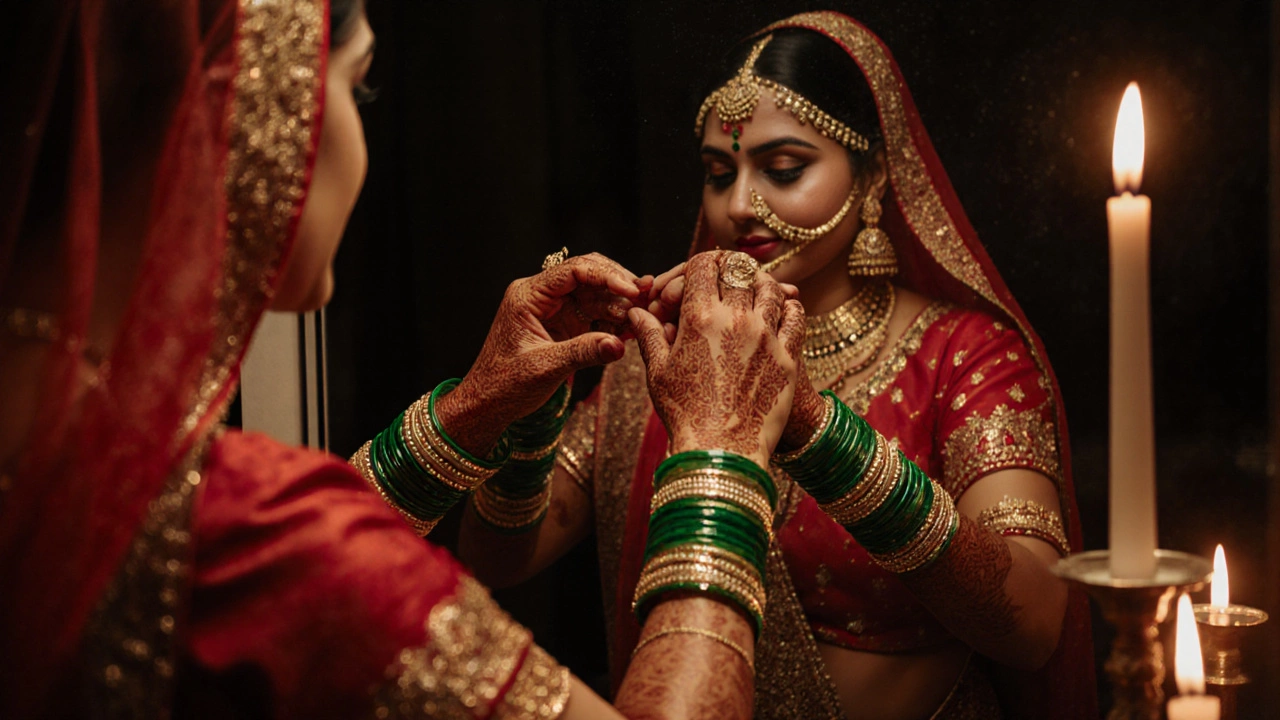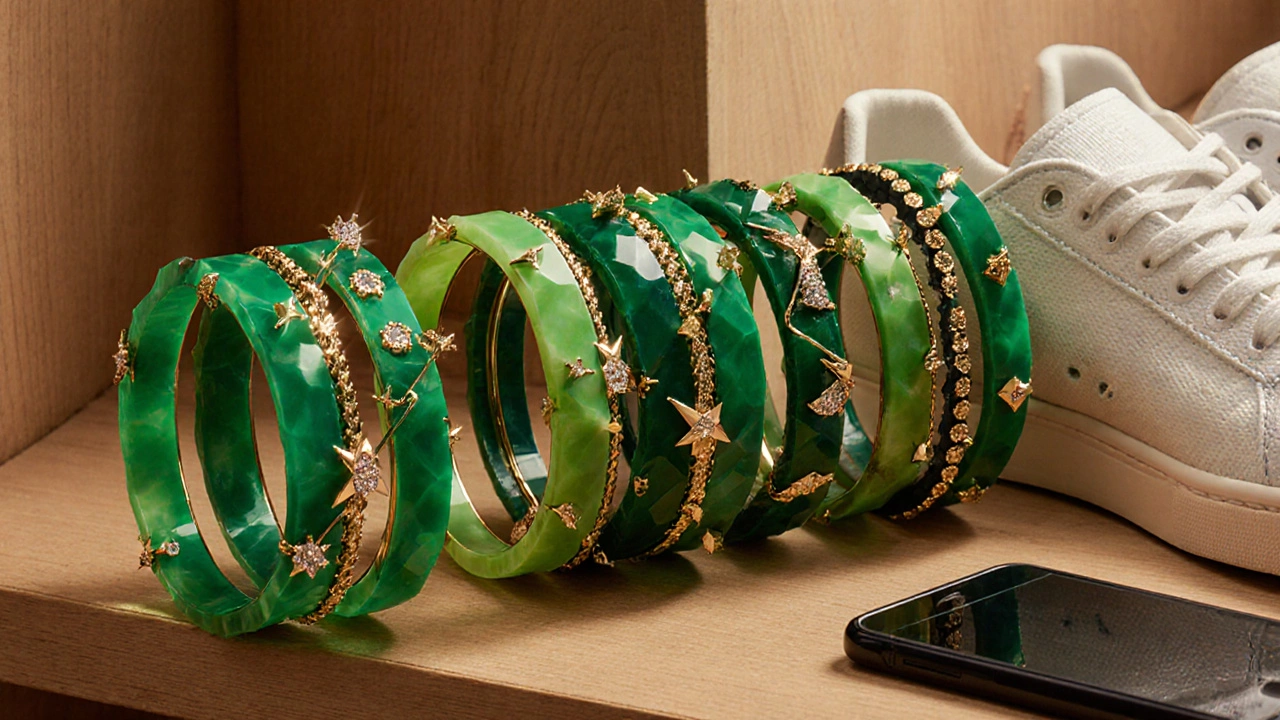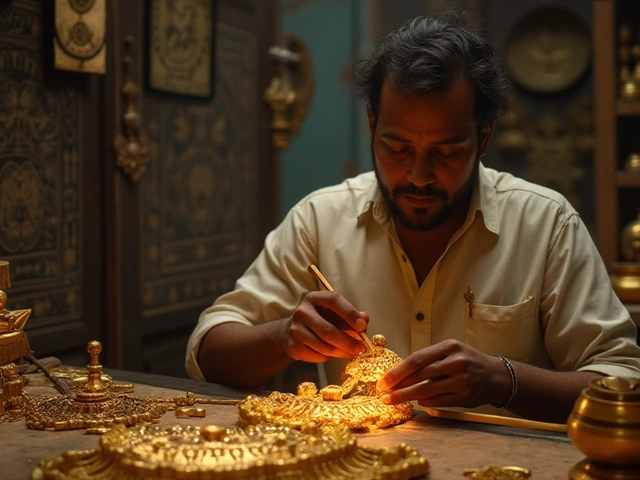Bangle Choice Assessment Tool
Your Background
Answer these questions to get personalized guidance
How This Works
This tool helps you understand how cultural context affects wearing green bangles. Based on your answers, you'll receive personalized guidance that considers both tradition and modern perspectives.
Your Assessment Results
For generations, Indian women have worn bangles as more than just jewelry-they’re symbols of identity, status, and celebration. But when it comes to green bangles, a lot of confusion lingers. Can an unmarried girl wear them? The answer isn’t as simple as yes or no. It depends on where you’re from, what your family believes, and how you see tradition today.
What Green Bangles Mean in Indian Culture
Green is one of the most powerful colors in Indian symbolism. It stands for fertility, growth, new beginnings, and prosperity. In many parts of India, especially in rural areas and among older generations, green bangles are strongly tied to marriage. They’re often part of a bride’s wedding set, paired with red or gold, because they’re believed to bring good luck to the new household. In states like Bihar, Uttar Pradesh, and parts of Rajasthan, married women traditionally wear green glass bangles on their wrists as a visible sign of their marital status.
But here’s the thing: this rule was never written in stone. It was passed down through generations of women sharing stories at family gatherings, not through religious texts or laws. And even then, it wasn’t universal. In South India, for example, green bangles are rarely worn by married women at all. Instead, they favor gold or ivory bangles. In Bengal, married women wear red and white bangles, not green. So the idea that green = married is regional, not national.
Why the Myth Persisted
The belief that only married women can wear green bangles likely came from a mix of superstition and social control. In the past, families wanted to make sure young girls were clearly seen as unmarried-so their clothing, jewelry, and even nail color were regulated. Green bangles, being so closely linked to brides, became a visual cue. If a girl wore them, people might assume she was already married or trying to act like she was. That could lead to gossip, unwanted attention, or even pressure to marry early.
Also, green glass bangles are fragile. They break easily. In some communities, a broken bangle was seen as a bad omen-especially if it happened to a married woman. So, families discouraged unmarried girls from wearing them, not just to avoid confusion, but to prevent any chance of bad luck.
Times Have Changed
Today, young women across India are redefining tradition. Walk into any college campus in Delhi, Bangalore, or Pune, and you’ll see girls wearing green bangles-sometimes with jeans and T-shirts, sometimes stacked with silver cuffs. They’re not trying to pretend they’re married. They’re wearing them because they like the color. They love how it pops against their skin. They’ve seen Bollywood stars like Deepika Padukone and Alia Bhatt wear green bangles in films and on red carpets, and they’re inspired.
Designers have noticed too. Brands like Tanishq, CaratLane, and even small local artisans now make green bangles in resin, metal, and enamel-not just glass. They’re marketed as fashion pieces, not marital symbols. You can find green bangles with tiny diamonds, geometric patterns, or even neon shades. They’re sold in the same section as pink and blue bangles, with no warnings about who can wear them.

What Religious Texts Actually Say
There’s no verse in the Vedas, the Upanishads, or any Hindu scripture that says unmarried girls can’t wear green bangles. The rules around bangles come from local customs, not sacred texts. Even in ancient texts like the Mahabharata or Ramayana, there’s no mention of color restrictions for unmarried women. The emphasis was always on the *number* of bangles (odd numbers were preferred), the *material* (gold, ivory, shell), or the *sound* they made when clinking together-not their color.
So if someone tells you it’s ‘against religion’ for an unmarried girl to wear green bangles, they’re mixing culture with faith. That’s not the same thing.
Family Reactions and Social Pressure
Even though the rules have softened, some families still hold on tight. If you’re from a conservative household, wearing green bangles might spark a conversation-or even a lecture. Your grandmother might say, ‘That’s for brides,’ and your mother might worry about what neighbors will think.
But here’s the reality: most families today care more about your happiness than your bangles. If you explain that you love the color, that it makes you feel confident, and that you’re not trying to break any rules-most will soften. A lot of parents who once objected have changed their minds after seeing their daughters wear green bangles to college interviews, job fairs, or even weddings as guests.
One woman from Lucknow told me she wore green bangles to her sister’s wedding-just as a fashion statement. Her aunt scolded her in front of everyone. But her uncle, who works in IT in Hyderabad, laughed and said, ‘Back in my day, we thought only widows wore white. Now we wear white sneakers. Times change.’
Green Bangles Today: A Personal Choice
There’s no rulebook anymore. No priest, no government, no ancient text is going to stop you from wearing green bangles if you want to. Whether you’re 16 or 30, unmarried or engaged, the choice is yours.
Some women wear green bangles to honor their roots-maybe their mother wore them, or their village has a festival where green is sacred. Others wear them because they’re trendy. Some wear them on special days-like Raksha Bandhan or Diwali-as a nod to tradition without the pressure.
And if you’re unsure? Try this: wear them once. See how you feel. See how others react. If you get curious looks, smile. If someone asks, say, ‘I like the color.’ That’s enough.

What Other Colors Mean (And Who Can Wear Them)
It helps to understand the broader picture. Here’s a quick guide to common bangle colors and their traditional meanings:
- Red: Symbolizes marriage, passion, and energy. Most commonly worn by brides.
- Gold: Represents wealth, prosperity, and status. Worn by married women across India.
- White: Traditionally worn by widows in some communities. Avoided by unmarried women in those regions.
- Pink: Associated with youth, joy, and innocence. Popular among girls and teens.
- Yellow: Linked to prosperity and happiness. Often worn during festivals like Teej.
- Black: Used to ward off evil. Common in rural areas, worn by both married and unmarried women.
Notice something? None of these are locked to marital status. Even red-often called the ‘bridal color’-is now worn by unmarried girls during festivals. The meaning has evolved with the times.
Modern Women Are Rewriting the Rules
Today’s young Indian women aren’t rejecting tradition-they’re reshaping it. They’re keeping what feels meaningful and letting go of what feels outdated. Green bangles? They’re not a secret signal of marriage anymore. They’re a splash of color, a statement of style, a quiet rebellion against old expectations.
One college student from Jaipur told me she wears green bangles every day. ‘My mom thought I was going to get married next week,’ she laughed. ‘I told her I’m not marrying anyone until I finish my PhD. She still wears them too-just because she likes them now.’
That’s the real story here. Tradition isn’t about following rules. It’s about carrying forward what gives you joy, meaning, and strength.
Final Answer: Yes, Absolutely
An unmarried girl can wear green bangles. There’s no religious, legal, or cultural rule that stops her. What once was a regional custom has become a personal choice. The only thing that matters now is how you feel when you wear them.
If you love the color, wear them. If they make you feel strong, wear them. If they remind you of your grandmother’s smile or your favorite summer festival, wear them. No one else gets to decide what your jewelry means.
Can unmarried girls wear green bangles in South India?
In South India, green bangles are rarely part of traditional bridal wear. Women there favor gold, ivory, or red bangles. So the idea that green = married doesn’t really apply. Unmarried girls in Tamil Nadu, Kerala, or Karnataka wear green bangles without any social concern-it’s just seen as fashion.
Do green bangles bring bad luck if broken?
In some rural communities, a broken bangle-especially glass ones-is seen as an omen. But this belief is fading fast. Modern bangles are made from resin, metal, or silicone, which don’t break easily. Even where glass is still used, most people now see a broken bangle as just a coincidence, not a sign.
Are green bangles only for Hindus?
No. Women from Muslim, Christian, and Sikh communities in India also wear green bangles as fashion accessories. In cities like Mumbai and Hyderabad, you’ll find Muslim girls wearing green bangles with their salwar kameez. It’s no longer tied to religion-it’s about personal taste.
What if my family says it’s wrong?
Start by asking why they think so. Often, it’s based on something they heard from their mother or grandmother. Share what you’ve learned-how traditions change, how green bangles are now worn by celebrities and designers. Give them time. Many families soften once they see it’s not about rebellion, but self-expression.
Can I wear green bangles to a wedding?
Yes, absolutely. Many guests wear green bangles to weddings today. Just avoid wearing a full set of red and green bangles if you’re not the bride-that can be confusing. But as a single piece, or with other colors, it’s perfectly fine.



